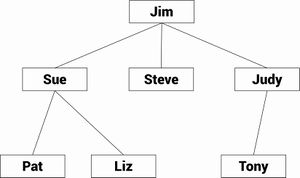Difference between revisions of "Trees"
(→What is a Binary Tree Search) |
(→What is a Binary Tree Search) |
||
| Line 29: | Line 29: | ||
##If it is alphabetically Lower than the root the new item will be placed on the left of the root. If the root already has a node to the left, the new item will be compared to this node as well. | ##If it is alphabetically Lower than the root the new item will be placed on the left of the root. If the root already has a node to the left, the new item will be compared to this node as well. | ||
##If it is alphabetically Higher than the root the new item will be place to the right of the root. If the root already has a node to the Right, the new item will be compared to this node as well. | ##If it is alphabetically Higher than the root the new item will be place to the right of the root. If the root already has a node to the Right, the new item will be compared to this node as well. | ||
| + | |||
| + | [[File:Binary tree.gif]] | ||
Revision as of 10:15, 29 November 2017
Contents
What is a Tree
A tree is a connected, undirected graph with no cycles in it.
Connected
All nodes must be connected to other nodes so that no part of the graph is separated. An unconnected graph is essentially 2 separate graphs.
Undirected
A tree can't have any directed edges/arcs. This will be an arrow on the edge/arc to indicate the direction of travel.
No Cycles
A run of interconnected nodes that return to the point of origin.
What is a Rooted Tree
A tree with one vertex singled out as a starting point.
What is a Binary Tree
A binary tree is a graph with no cycles in which each node is succeeded by a maximum of 2 nodes, a 'left' child and a 'right' child, therefore they can be either directed or undirected.
What is a Binary Tree Search
A binary tree can be created from a list of data:
- The first item in the list will be the root of your tree.
- You will then add an item to the tree by firstly comparing the new item to the root.
- If it is alphabetically Lower than the root the new item will be placed on the left of the root.
- If it is alphabetically Higher than the root the new item will be place to the right of the root.
- The next item in the list will again be compared to the root.
- If it is alphabetically Lower than the root the new item will be placed on the left of the root. If the root already has a node to the left, the new item will be compared to this node as well.
- If it is alphabetically Higher than the root the new item will be place to the right of the root. If the root already has a node to the Right, the new item will be compared to this node as well.
